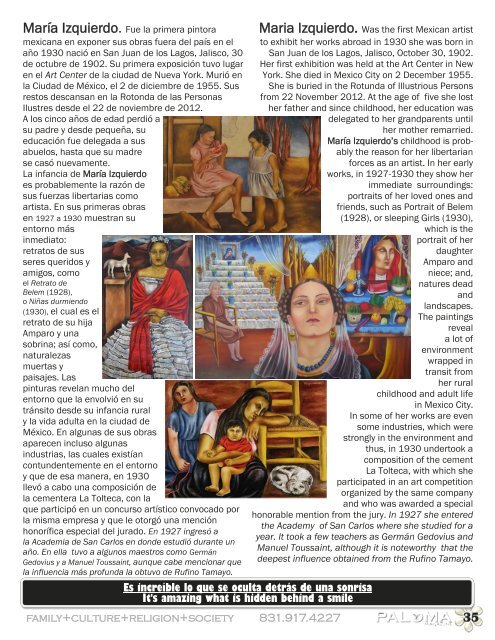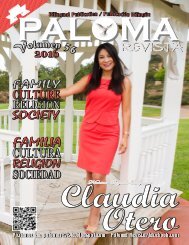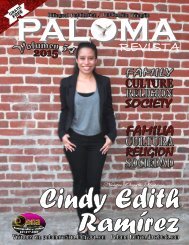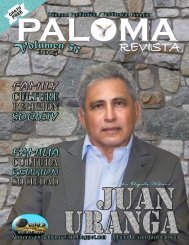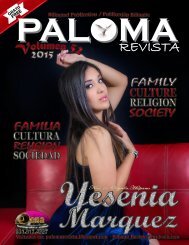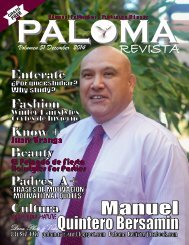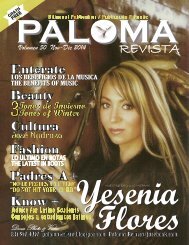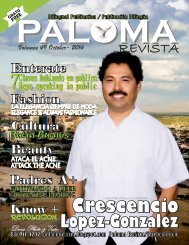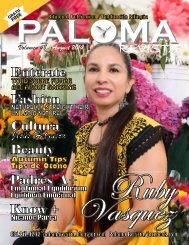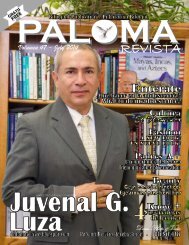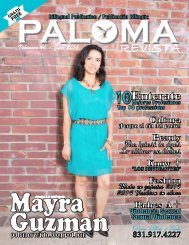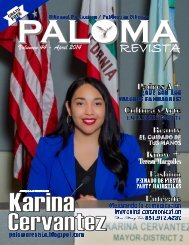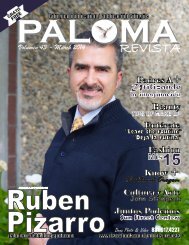PALOMA MAGAZINE VOLUME 55
Family, culture, religion, society, history, Salinas California, Quinceaneras, Weddings, fashion, beauty, phrases, messages, thoughts, poetry, youth, children, community.
Family, culture, religion, society, history, Salinas California, Quinceaneras, Weddings, fashion, beauty, phrases, messages, thoughts, poetry, youth, children, community.
- No tags were found...
Create successful ePaper yourself
Turn your PDF publications into a flip-book with our unique Google optimized e-Paper software.
María Izquierdo. Fue la primera pintora<br />
mexicana en exponer sus obras fuera del país en el<br />
año 1930 nació en San Juan de los Lagos, Jalisco, 30<br />
de octubre de 1902. Su primera exposición tuvo lugar<br />
en el Art Center de la ciudad de Nueva York. Murió en<br />
la Ciudad de México, el 2 de diciembre de 19<strong>55</strong>. Sus<br />
restos descansan en la Rotonda de las Personas<br />
Ilustres desde el 22 de noviembre de 2012.<br />
A los cinco años de edad perdió a<br />
su padre y desde pequeña, su<br />
educación fue delegada a sus<br />
abuelos, hasta que su madre<br />
se casó nuevamente.<br />
La infancia de María Izquierdo<br />
es probablemente la razón de<br />
sus fuerzas libertarias como<br />
artista. En sus primeras obras<br />
en 1927 a 1930 muestran su<br />
entorno más<br />
inmediato:<br />
retratos de sus<br />
seres queridos y<br />
amigos, como<br />
el Retrato de<br />
Belem (1928),<br />
o Niñas durmiendo<br />
(1930), el cual es el<br />
retrato de su hija<br />
Amparo y una<br />
sobrina; así como,<br />
naturalezas<br />
muertas y<br />
paisajes. Las<br />
pinturas revelan mucho del<br />
entorno que la envolvió en su<br />
tránsito desde su infancia rural<br />
y la vida adulta en la ciudad de<br />
México. En algunas de sus obras<br />
aparecen incluso algunas<br />
industrias, las cuales existían<br />
contundentemente en el entorno<br />
y que de esa manera, en 1930<br />
llevó a cabo una composición de<br />
la cementera La Tolteca, con la<br />
que participó en un concurso artístico convocado por<br />
la misma empresa y que le otorgó una mención<br />
honorífica especial del jurado. En 1927 ingresó a<br />
la Academia de San Carlos en donde estudió durante un<br />
año. En ella tuvo a algunos maestros como Germán<br />
Gedovius y a Manuel Toussaint, aunque cabe mencionar que<br />
la influencia más profunda la obtuvo de Rufino Tamayo.<br />
Maria Izquierdo. Was the first Mexican artist<br />
to exhibit her works abroad in 1930 she was born in<br />
San Juan de los Lagos, Jalisco, October 30, 1902.<br />
Her first exhibition was held at the Art Center in New<br />
York. She died in Mexico City on 2 December 19<strong>55</strong>.<br />
She is buried in the Rotunda of Illustrious Persons<br />
from 22 November 2012. At the age of five she lost<br />
her father and since childhood, her education was<br />
delegated to her grandparents until<br />
her mother remarried.<br />
María Izquierdo’s childhood is probably<br />
the reason for her libertarian<br />
forces as an artist. In her early<br />
works, in 1927-1930 they show her<br />
immediate surroundings:<br />
portraits of her loved ones and<br />
friends, such as Portrait of Belem<br />
(1928), or sleeping Girls (1930),<br />
which is the<br />
portrait of her<br />
daughter<br />
Amparo and<br />
niece; and,<br />
natures dead<br />
and<br />
landscapes.<br />
The paintings<br />
reveal<br />
a lot of<br />
environment<br />
wrapped in<br />
transit from<br />
her rural<br />
childhood and adult life<br />
in Mexico City.<br />
In some of her works are even<br />
some industries, which were<br />
strongly in the environment and<br />
thus, in 1930 undertook a<br />
composition of the cement<br />
La Tolteca, with which she<br />
participated in an art competition<br />
organized by the same company<br />
and who was awarded a special<br />
honorable mention from the jury. In 1927 she entered<br />
the Academy of San Carlos where she studied for a<br />
year. It took a few teachers as Germán Gedovius and<br />
Manuel Toussaint, although it is noteworthy that the<br />
deepest influence obtained from the Rufino Tamayo.<br />
Es increíble lo que se oculta detrás de una sonrisa<br />
It's amazing what is hidden behind a smile<br />
family+culture+religion+society 831.917.4227 35


